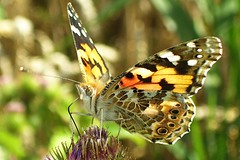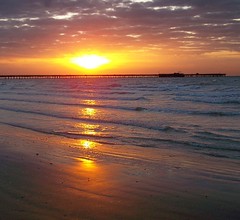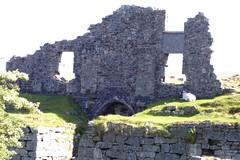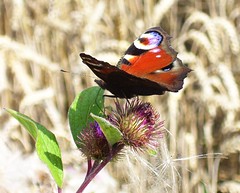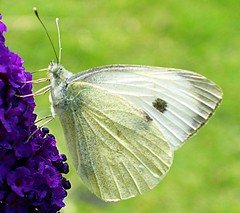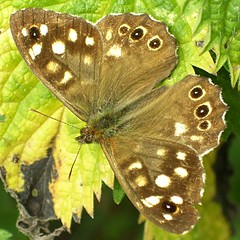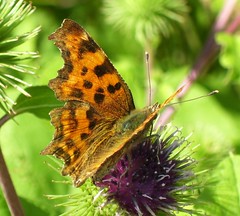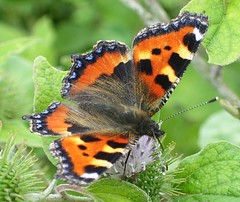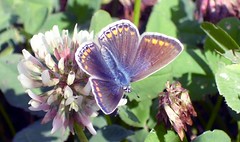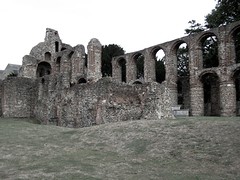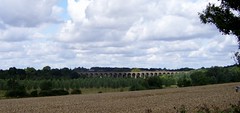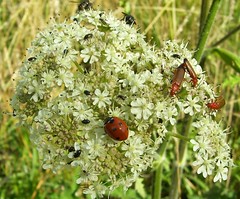It is the Clacton Air Show tomorrow. I had not realised what sort of commercial excitement this aroused in the bosom of the town. Large catering vans have come from far and wide. Never over-estimate the distance someone is willing, or able, to walk to hammer down food. Heaven forbid the throngs of people had to go into town to get food, or visit the pubs. Walks of 200 yards are not wise for some people.
I am not sure of the relationship these vans have with the local business community. If I were to guess the council sell trading concessions on the basis it is good for everyone. Everyone but the local shopkeeper, but tough on them, unable to move, a captive when the business rates fall due, what does the council care about them.
One pub, built on the remains of a Butlin’s Camp which disappeared under a housing estate long ago, trumpets it is open all day serving food, for the duration of the airshow. It gives a hint of the sort of economic whirl they live in. The airshow runs from 1pm to 5pm for two days.
When the show starts only locals will know of the secret parking places which will allow them to get within two miles of a decent view of the activities. Today there is no problem, I drive past the spot I hope to make my viewing platform tomorrow and continue on. The pub with the proud boast it has the economic stamina to stay open for 2 whole days is my general destination.
Clacton seafront sort of fizzles out at this point, but the iron grip of the by-law pertains. No pleasure to small not to have an associated by-law, which begins “Do not…”
The ones which relate to me are dogs banned from the beach, dogs to be kept on a lead at all times. The one that don’t relate to me, no drinking in public and various restrictions as to what cannot be done in the sea and carparks.
I only have to get past the outfall pipe to shrug off these by-laws. It say’s so on the signs, the outfall pipe is even named on the OS, it is a feature.
Near where I parked is a lump of rock and upon it is screwed a rectangular plaque. It garners as much interest as brown plaques on brown rocks in slightly out of the way places can expect. It marks a terminus of a Churchill trinity, one I have been meaning to do for some time now. If I am honest with myself, I don’t really want to do it, but having thought it up it is going to nag me till I do. Sub-consciously I am in search of a shorter or better Churchill trinity. In the meanwhile I keep searching for facts and stories about the places that will be walked past to help breathe life into the landscape.
The stone marks where a young Churchill came spluttering to shore after an incident involving an unreliable aircraft whose feeble engine ditched him into the sea nearby. All this long before World War Two and by-laws prohibiting this sort of accident.
The weather is just gearing up for the airshow and bank holiday generally. The wind is fresh enough to blow the cobwebs from your mind, that is if you can keep your head attached to your shoulders and it rains. Not a deluge, but we are not talking about romantic strolls on dog free golden sands, sun glinting off the outfall pipe, just beyond which you can only make out the merest hint of the sort of bedlam a world in which dogs roam free can be.
Suits me fine, I don’t cart a rucksack about to be ill-prepared. Okay, I admit to having a dog under each arm because I forgot the dog leads.
This walk is of course part of the “ragged edge tour” and from the title you can assume, a trinity. The ‘tella’s are Martello Towers.
29 were constructed along the East Coast, the line starts from St. Osyth, near Clacton and continues Northwards to Aldeburgh in Suffolk. Of the 29, 18 still stand, 3 only by willpower and are on the buildings at risk register.
They were built between 1808-1812 and have the architectural fashion of massive, slightly out of shape, sandcastles. There are certain design variations, but most people think of them as round which they sort of are. There is another line of these defences on the South coast, but they are inferior in build.
They were designed to give Boneparte second thoughts when it came to invading, in the same sort of manner pillboxes were organised against Hitler. Neither invaded so the defences were never tested, a good thing.
The first of the towers, will be visited last, it is nearer the town than I want to go with dogs lacking leads, full bomb bays and much to much energy. We all make tracks for the not so imaginary demarcation line, the outfall pipe. The rain is persistent but not unwelcome, the area is left to the underclass of dog walkers. Water quality is on the upward trend, probably as much to do with falling tourist numbers as anything the water companies do, but the water companies take the glory and raise prices.
The second Martello Tower sits on the edge of the coastline, erosion stopped by a sea wall, and now sand dunes have developed, the sea no longer having the willpower to stray that far up the beach.
This in large part due to the hideously ugly Y shaped breakwaters comprising of green slimed boulders, if there was a cheaper uglier option I am sure they would have gone with it.
The dogs are let loose, they run and gambol, fighting each other playfully, you would think they never got out. A fishing boat, flat bottomed, sits on the sand, waiting patiently for the tide and a return to its intended environment, it will not have to wait long. Three or four large seaweed festooned ropes lie near it, presumably for other boats to be moored. Last time I was here there were some tired tractors sitting in the dunes used for the movement of boats, they are not here now. It raises questions in my mind, is it a decline of industry, a tidying up exercise by the council, or do these things return when there are less tourists about to be tempted into vandalism?
The dry sand is soft, walking ten miles on that is going to be difficult for the dogs, last year, admittedly on a much hotter day, dog 2 got into difficulty and had to be carried. With this in mind, we walk lower on the beach, firmer sea washed sand, but it is a balancing act, the breakwaters have calmed the sea, soft mud has developed, and they mean it. Go too low and you can feel yourself sinking, the evidence clear in ever deepening footprints. In 2001 a man went a step too far, sank straight up to his waist in mud, water was lapping around his chest by the time he was released with the aid of compressed air. The story could easily have ended differently.
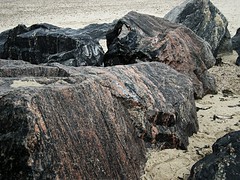
Boulders have been brought in to help the feeble native sands withstand the onslaught of the sea. A lot of these boulders having interesting patterns, folded sediments from eons ago, one is naturally a bright green. I like them, pictures are taken. Weather rusted signs, apparently dating from the 2001 incident, but looking much older than that warn of the mud.
The charming coves created by huge boulder strewn breakwaters are mine alone. Peeping over sea defences is the shanty town that is Jaywick. Created as a cheap holiday retreat, poorly constructed for the poor, were built 50 years ago. Today people live permanently in the same houses, even if they look boarded up. The Jaywick page on wikipedia and I quote at time of writing :
“Shotings have been knowan in Jaywick and stabbings are a regular accurancs.”
Perfect summation. Rodent faced youths don’t look you in the eye, they check out your trainers, bad luck for you if they have a high resale value. Making eye contact is a prelude to a fight, not a greeting. Humans are the most dangerous, unpredictable animal you are likely to meet, treat accordingly.
The sea defences were erected after the 1953 floods killed 37 of the 700 inhabitants, others died later of exposure. The place got rebuilt, a shabbier version of itself. Just last week a google news alert arrived hot off the presses. Local Jaywick people were up in arms at the suggestion they should move out of their shanty dwellings and do the area a favour.
Head down bully and shove. Seawick is ahead.
Just before you reach Seawick, the third and for this part, final Martello Tower. This one is open to the public, painted white, and is in fact an art gallery, in the local sense of the word. It is free to enter and I am sorely tempted, but with two dogs, no leads, I don’t. It will be a part of another journey one day.
The weather is improving and so is the walking, the thought of turning back and repeating what I have just been past so soon drives me ever forward.
If you can avoid the “shotings” and other “accurancs” then all is fine. Let us gloss over Seawick, a place of homes with pretensions to being mobile, any direction but upwardly, by the looks of it. I confess by now a certain melancholy is setting in. Next to the mobile homes that don’t move are garages with picture windows with great views of a sea defence wall. Cars are parked outside, the people live in the garages. This is where you end up if you do actually slip through the cracks in the pavement, it just takes fate a little time to process your application. You don’t mean to end up there but life often comes down to two bad choices.
I am on the beach though. If I look at the beach, or out to sea I could be anywhere. Well anywhere with ugly breakwaters, death trap mud and a large windfarm being built on the sea. Windfarms are the green answer for people that don’t live near them.
The things I am happy to do in the name of trinity. Eventually though even the last pretence of housing is over. I imagine the area to be a more civilised version of gold rush towns of the US, just with less hope. I am trying to shift perspective, make the place mentally more appealing imagining it populated by Wyatt Earp and Doc Holliday. Maybe 100 years from now, some extravagant myth-telling and a needy heritage industry will come to the rescue of a place where “Shotings have been knowan”.
Line dancing and dressing up as a cowboy is common enough to not be a laughing matter in these parts. It is probably fighting talk to suggest different, but then most talk is fighting talk around these parts.
One final surprise, the most unappetizing naturist beach. 1000 metres of mud and rock, the only people on it sensibly clad in jackets. This attempt at hedonism does not last long, wrong time, wrong place, very wrong bodies.
I am in the prairies now, clinging to my illusions, land below sea-level stretches before me, two farm silo’s pierce the horizon, it has even stopped raining. The sea wall is an emergency measure rather than a regular necessity by the looks of it, a large expanse of marsh separates me from the sea. Various man made structures litter it, purpose lost in time. Lichen grows on the concrete defences, blackberry bushes grow on the seaward side. A place the sea does not want.
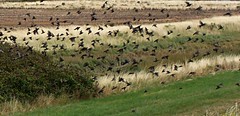
There is a row of telephone poles, perhaps electricity, I cannot be sure. The wires are strung between them and a flock of birds have gathered. Every so often they swoop down in great number feasting on the blackberry bushes, they are surely packing their stomachs getting ready to leave for warmer climes.
The march of the wire hints at something else to come, something more remote than what has gone before. There is, it is Lee-over-Sands. This is the remains of a 1930’s holiday park, what Jaywick would have been like if they stopped rebuilding it, less being better.
There is not much left at all, just an unmade road which leads up to a sewage works. A fine pillbox remains along with the concrete blocks either side of it, to make sure nobody sneaks around it. I have reached Colne Point Nature reserve. Another excuse to demand dogs are put on leads. Large green signs explain what you cannot do there out in the back of beyond. The small print on the back of the large sign explains reckless or intentional disturbance of the flora can lead to a 20,000 pound fine.
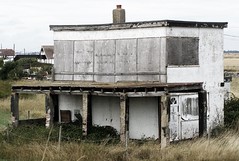
These ludicrously large fines are fair indications of the chances of being caught. The higher the fine the smaller the chance, the sheer size of the fine designed to stun you into obedience in the absence of any possible enforcement. Reckless plant disturbance would have once been worthy of Monty Python sketches now it is the purview of large ugly signs telling us how delicate and important the wasteland is.
I am finally defeated, I take a picture of a house which surely must be the end of the line. It is time to return back to the car.
Walking back there are a few surprises. The weather has improved enough that it is possible for people to venture out in coats and jackets. People of all ages are filling buckets with sand and imagining themselves to be having a good time. Some young ladies are actually in bikini’s. They go to the water, I slow my pace just a little, I want to hear the reaction I have heard a thousand times but never grows stale.
“Its bloody freezing” they shout over the wind, so their companion can hear. Their companion never accepts this without first hand knowledge, venturing in they find out for themselves. Only rarely will they get in over their ankles before rushing back up to the beach wondering what it was all about.
The remarkable thing being what do they expect?
If they were at home, would they be walking around in bikini’s hurling themselves into a local canal? Would folk of all ages be in their back gardens filling small plastic buckets with earth making mud-castles? What is it about a sea-breeze that drives all common sense out of people’s minds?
12 odd miles, there and back again, the exercise was nice. I have no real conclusion, mentally I am conflicted about what I saw. Emotionally though I am depressed which is probably the litmus test, it was a depressing place.
